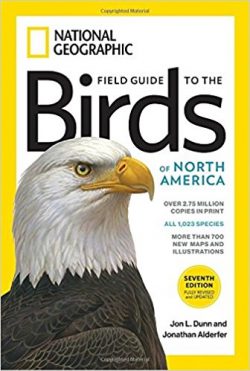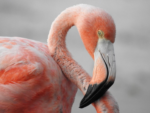Every Friday we invite you and your homeschool students to learn about a different group of North American birds in your recommended bird guide. It’s a great way to add a few minutes of science, geography, natural history, and imagination to your homeschool schedule throughout the year.
This week’s birds (two different families) are the Shrikes (pages 356–357) and the Vireos (pages 358–365).
If you’re teaching younger children, the way to use these posts is just to treat your bird guide as a picture book and spend a few minutes each week looking at all the interesting birds they may see one day. With that, your little lesson is done.
If you have older students, one of your objectives should be to help them become fluent with a specialized reference book that’s packed with information, the kind of book they will encounter in many different fields of study. Here’s how your bird guide introduces this week’s birds:
SHRIKES — Family Laniidae. These masked hunters, which lack raptorial feet, scan the countryside from lookout perches and then swoop down on insects, rodents, snakes, and small birds. Their flight is rapid and undulating. Known as “butcher-birds,” they mostly impale their prey on thorns. Recent research indicates that this is to mark territory and attract mates. Species: 34 World, 3 N.A. [North America]
VIREOS — Family Vireonidae. Short, sturdy bills slightly hooked at the tip characterize these small songbirds. Vireos are closely related to the shrikes. Some have “spectacles” and wing bars. Others have eyebrow stripes and no wing bars. They are generally chunkier and less active than warblers. Species: 62 World, 17 N.A.
When you’re training your young naturalists, teach them to ask and answer from their bird guide some of the first questions any naturalist would ask about a new group — about the Shrikes, for example. How many species? (34 worldwide.) Are there any near us? (Two species in North America generally, plus a third that occurs only in Alaska; the individual maps will give us more detail.) What are their distinctive features? (Predatory, undulating flight, black mask, and so on.) (And “undulating” is certainly a wonderful word, isn’t it — be sure to send someone to your homeschool dictionary to look that one up!) 🔎
Pick a representative species or two to look at in detail each week and read the entry aloud, or have your students study it and then narrate it back to you, explaining all the information it contains. This week, for the Shrike family, why not investigate a widespread though uncommon bird: the Loggerhead Shrike (page 356).
All sorts of biological information is packed into the brief species descriptions in your bird guide — can your students tease it out? How big is the Loggerhead Shrike? (Nine inches long.) What is its scientific name? (Lanius ludovicianus.) Will you be able to find this species where you live? At what times of year and in what habitat? (Study the range map and range description carefully to answer those questions, and see the book’s back flap for a map key.) Do the males and females look alike? The adults and juveniles? What song or call does this species make? How can you distinguish it from similar species? (The text and illustrations should answer all these questions.)
Shrikes are relatively small birds that belong to the overall “songbird” group, but they are predators, almost like tiny hawks. As the description above indicates, they hunt large insects, small snakes, and small mammals and birds, and they are famous for impaling their prey on thorn bushes — hence the colloquial name “butcher-birds.” If you ever see a hawthorn or locust tree with a dead mouse or a dead sparrow jammed onto one of its spikes, you can be pretty sure there is a shrike in the neighborhood.
The Loggerhead Shrike occurs across much of the United States, especially in the southern tier; the very similar Northern Shrike (Lanius excubitor) also occurs across the continent but is generally found in the northern states and Canada.
For this week’s second family, the Vireos, why not look at the Red-eyed Vireo (page 362), a species that is widespread across much of eastern North America.
Unless you’re a serious birder you’ve probably never seen a Red-eyed Vireo, but if you’ve spent any time in the eastern woodlands in the summer, there’s a good chance you’ve heard one, perhaps without knowing it. Red-eyed Vireos are quite common birds of the forest canopy, but they don’t often come down to ground level except occasionally on migration. They are, however, among the most incessant singers you’ll ever hear. Here’s one Red-eyed Vireo in West Virginia singing its pleasant woodland warble for 27 minutes:
You can do little ten-minute lessons of this kind with any of the species in your bird guide that catch your interest. Pick one that lives near you, or that looks striking, or that has a strange name, and explore.
In all these Friday Bird Families lessons, our aim is not to present a specific set of facts to memorize. We hope instead to provide examples and starting points that you and your students can branch away from in many different directions. We also hope to show how you can help your students develop the kind of careful skills in reading, observation, and interpretation that they will need in all their future academic work.
What ornithological observations and naturalistical notes will you and your students be making in your homeschool this Leo Term? 😊
❡ Homeschool birds: We think bird study is one of the best subjects you can take up in a homeschool environment. It’s suitable for all ages, it can be solitary or social, it can be as elementary or as advanced as you wish, and birds can be found just about anywhere at any season of the year. Why not track your own homeschool bird observations using the free eBird website sponsored by Cornell University. It’s a great way to learn more about what’s in your local area and about how bird populations change from season to season. 🦅
❡ Feed the birds: Setting up a bird feeder is one of the easiest educational activities you can do in a homeschool environment. Here are some tips that will help you get started today! 🐦
❡ Enchiridion: The front matter in your bird guide (pages 6–13) explains a little bit about basic bird biology and about some of the technical terminology used throughout the book — why not have your students study it as a special project. Have them note particularly the diagrams showing the parts of a bird (pages 10–11) so they’ll be able to tell primaries from secondaries and flanks from lores. 🦉
❡ Words for birds: You may not think of your homeschool dictionary as a nature reference, but a comprehensive dictionary will define and explain many of the standard scientific terms you will encounter in biology and natural history, although it will not generally contain the proper names of species or other taxonomic groups that aren’t part of ordinary English. (In other words, you'll find “flamingo” but not Phoenicopterus, the flamingo genus.) One of the most important things students should be taught to look for in the dictionary is the information on word origins: knowing the roots of scientific terms makes it much easier to understand them and remember their meaning. 📖
❡ Come, here's the map: Natural history and geography are deeply interconnected. One of the first questions you should teach your students to ask about any kind of animal or plant is, “What is its range? Where (in the world) does it occur?” Our recommended homeschool reference library includes an excellent world atlas that will help your students appreciate many aspects of biogeography, the science of the geographical distribution of living things. 🌎
❡ Nature notes: This is one of our regular Friday Bird Families posts for homeschool naturalists. Print your own copy of our River Houses Calendar of American Birds and follow along with us! You can also add your name to our free weekly mailing list to get great homeschool teaching ideas delivered right to your mailbox all through the year. 🐦 🦉 🦆 🦃 🦅
❡ Homeschool calendars: We have a whole collection of free, printable, educational homeschool calendars and planners available on our main River Houses calendar page. They will help you create a light and easy structure for your homeschool year. Give them a try today! 🗓
❡ Support our work: If you enjoy our educational materials, please support us by starting your regular Amazon shopping from our very own homeschool teaching supplies page. When you click through from our page, any purchase you make earns us a small commission at no extra cost to you. Thank you for helping us to keep going and growing! 🛒
❡ Join us! The aim of the River Houses project is to create a network of friendly local homeschool support groups — local chapters that we call “Houses.” Our first at-large chapter, Headwaters House, is now forming and is open to homeschoolers everywhere. Find out how to become one of our founding members on the Headwaters House membership page. 🏡




